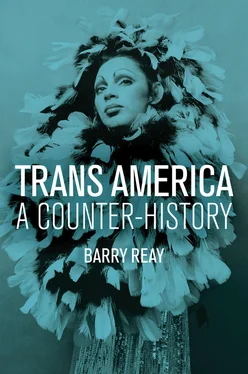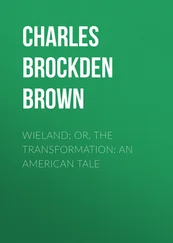But, whatever the favoured medium, narrative, or cited forerunner, the tendency has been to obscure what this book will argue was a contested and troubled – even provisional – past. In Drucker’s representation, the 1960s seem lost in the mists of time: ‘For the 1960s, that was so forward thinking.’ 81For genderqueer, nonbinary Jacob Tobia, the 2000s – inconceivably, given all that you will read in this book – provided no language to describe their genderless feelings, and 2009 is almost ancient history: ‘no one knew who Laverne Cox was yet (can you imagine?)’. 82Or take the historical introduction to Vanity Fair ’s 2015 special edition, Trans America , that denies any ‘smooth continuum’ from trans rejection to acceptance, yet which demonstrates the precise opposite by moving quickly to what it terms the ‘sustained high’ for transgender in contemporary US culture and to the celebrity trans promoted by that magazine. 83Lest it be argued that these are examples of popular rather than academic culture, consider Jack Halberstam’s recent book Trans* (2018), which, apart from a discussion of 1970s feminism, has almost nothing from the period before the 2000s. 84Of course CN Lester must be excluded from my criticism, for they have read widely in the historical literature and are thoughtful about the value of the past for the trans community: ‘What I have learnt about our histories shows me that the gendered bars and limits placed around us need not be permanent.’ 85Similarly, many of the contributors to the edited collection Trap Door (2017) are committed to recovering a useable trans history. 86But they are the exceptions that prove the rule.
When did this neglected history actually begin? Was it in the 1950s as already intimated? Or does this Jorgensen-inspired focus on those years distort a longer story? Julian Gill-Peterson has convincingly argued for ‘displacing the 1950s as a default starting point for trans history’. 87If it is possible to think of heterosexuality before heterosexuality, and homosexuality before homosexuality, why not think of transgender before transgender? 88What is the history of trans feelings, tendencies – it is difficult to find the right term – before transsexuality and transgender were named in the second half of the last century? How useful is it to claim transsexual subjectivities for the late nineteenth and early twentieth centuries? Chapter 1, ‘Before Trans’, deals with these issues.
Chapters 2to 4examine the so-termed transsexual moment. Janice Irvine, one of the most perceptive observers of the twentieth-century historical sociology of sex, has written of transsexuality’s ‘widespread public and professional acceptance’ by the 1970s, ‘an accepted syndrome, buttressed by a vast medical armamentarium of research, publications, and treatment programs’. 89But how seamless, really, was the triumph of transsexuality in the 1960s and 1970s? Chapter 2, ‘The Transsexual Moment’, discusses this ostensibly successful establishment of a new medical diagnosis and entity, arguing for the importance of cross-dressing (then known as transvestism) during this period of trans history. There is a case that the rather more fixed definitional qualities of the earlier 1960s and 1970s regime of transsexuality were necessary to establish a new category and to distinguish it from homosexuality and transvestism. However, we will see in Chapter 3, ‘Blurring the Boundaries’, that this sexual certainty masked a world of far more ambiguous alliances and practices. Chapter 4, ‘Backlash’, deliberates a neglected aspect of trans history, a period of intense critique right at the point where transsexuality had seemed to have become established.
Chapter 5, ‘The Transgender Turn’, considers the shift from transsexuality to transgender, and it assesses claims about the speed with which transgender has become established in the American cultural psyche. How, and in what ways, has that shift occurred? Has there been both a 1990s turn and a 2010s tipping point? Is trans culture really experiencing a cultural high?
Categories like transvestite, transsexual, transgender, and trans itself are good to rethink US history, but this book will demonstrate that it is the slippages and overlaps between these types that can be the most informative. As most dictionaries will explain, trans means across, beyond, over, and between; it can also denote change, transformation. 90The history that follows will include those with transgender bodies before transgender emerged as a descriptor; those who cannot be categorized as either transvestite or transsexual; cross-dressers who modify their bodies but who are not transsexual; those who wanted to be homosexual rather than heterosexual after their bodily reconstruction; and those who consider themselves beyond classification. This book will locate and contest some of the more significant structural and conceptual weaknesses in trans history: the neglect of an important period of critique in transsexuality’s early years; a claimed recognition of systems of technology and therapy and notions of sexual identity that I will suggest were far more tentative, contested, and fragmentary; and a neglect of other forms of trans expression both before and after the transsexual moment of the 1960s and 1970s. This book will attempt a new history of transsexuality and transgender in modern America.
1 1. M. L. Brown and C. A. Rounsley, True Selves: Understanding Transsexualism – For Families, Friends, Coworkers, and Helping Professionals (San Francisco, 1996), p. 25; J. F. Boylan, She’s Not There: A Life in Two Genders (New York, 2003), p. 174.
2 2. R. Erickson, ‘Foreword’, in R. Green and J. Money (eds.), Transsexualism and Sex Reassignment (Baltimore, 1969), p. xi.
3 3. M. W. Valerio, The Testosterone Files: My Hormonal and Social Transformation from Female to Male (Berkeley, 2006), p. 2.
4 4. E. B. Towle and L. M. Morgan, ‘Romancing the Transgender Native: Rethinking the Use of the “Third Gender” Concept’, GLQ, 8:4 (2002), 469–97. True Selves comes in for specific criticism in this regard (at 478).
5 5. C. Millot, Horsexe: Essays on Transsexuality, translated by K. Hylton (New York, 1990), p. 141. First published in French in 1983. Robert Stoller termed transsexualism ‘a newly described condition (the literature begins only in 1953)’: R. J. Stoller, The Transsexual Experiment (London, 1975), p. 2.
6 6. J. Meyerowitz, How Sex Changed: A History of Transsexuality in the United States (Cambridge, Mass., 2002), p. 1. See chs. 1 and 2.
7 7. H. Benjamin, The Transsexual Phenomenon (New York, 1966); Green and Money (eds.), Transsexualism and Sex Reassignment; Stoller, Transsexual Experiment. The term was really first used in print by the popular sexologist D. O. Cauldwell in 1949, as will be discussed in chapter 2.
8 8. The best history of transsexuality is Meyerowitz, How Sex Changed.
9 9. Ibid., pp. 217–22.
10 10. For an excellent short history of US transgender, see G. Beemyn, ‘US History’, in L. Erickson-Schroth (ed.), Trans Bodies, Trans Selves: A Resource for the Transgender Community (New York, 2014), ch. 22. The essay was published separately in a longer version as an Ebook: G. Beemyn, Transgender History in the United States (New York, 2014).
11 11. See, for example, R. Ekins and D. King, The Transgender Phenomenon (London, 2006); S. Stryker, P. Currah, and L. J. Moore, ‘Introduction: Trans-, Trans, or Transgender?’ Women’s Studies Quarterly, 36:3–4 (2008), 11–22; S. Stryker, Transgender History (Berkeley, 2008, 2017).
12 12. A. Bolin, In Search of Eve: Transsexual Rites of Passage (New York, 1988), p. 84.
13 13. W. O. Bockting, ‘Psychotherapy and the Real-Life Experience: From Gender Dichotomy to Gender Diversity’, Sexologies, 17:4 (2008), 211–24, quote at 214.
Читать дальше











